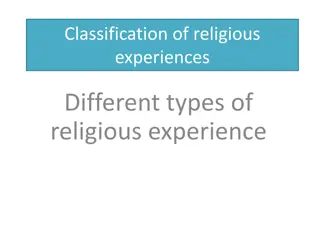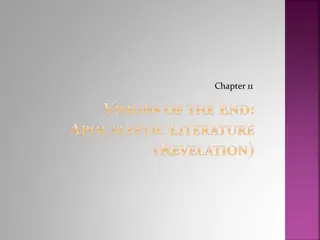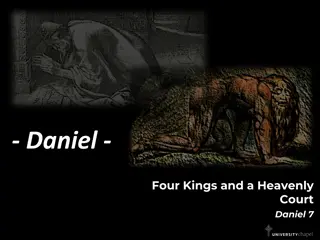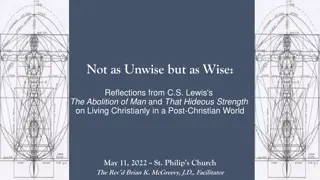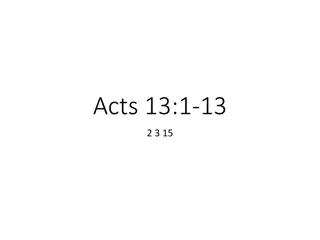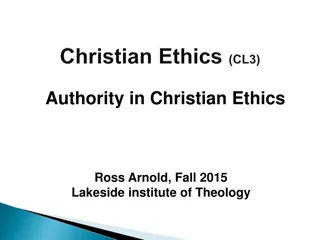Exploring Early Christian Apocalyptic Visions and Their Significance
Delve into the world of early Christian apocalyptic literature, uncovering profound visions that offer insights into heavenly mysteries. Discover the dual nature of apocalypses - vision and journey - and explore the rich history of Jewish and Christian apocalyptic texts. Engage in theological reflections on identity, divine judgment, and the concepts of heaven and hell. Witness how apocalyptic literature continues to thrive in contemporary American Christianity, shaping beliefs and perspectives on the afterlife.
Download Presentation

Please find below an Image/Link to download the presentation.
The content on the website is provided AS IS for your information and personal use only. It may not be sold, licensed, or shared on other websites without obtaining consent from the author. Download presentation by click this link. If you encounter any issues during the download, it is possible that the publisher has removed the file from their server.
E N D
Presentation Transcript
Session 3: Early Christian Apocalypses Christian Visions of the Unseen Order
Early Christian Apocalyptic Visions Questions for Theological Reflection 1. How do you balance your American identity with your Catholic identity? 2. In this Year of Mercy, what does the reality of heaven and hell say about God? 3. How does the season of Advent say about divine judgment?
Early Christian Apocalyptic Visions . Setting the Context
What is an apocalypse and apocalyptic literature? The term apocalypse comes from the Greek term apokalypsis meaning unveiling. Apocalyptic literature refers to writings that claim to unveil or reveal something hidden, often involving heavenly or otherworldly mysteries. These writings were popular among ancient Jews and Christians. And they remain popular today.
Apocalyptic literature is alive and well in 21stcentury American Christianity Proof of Heaven: A Neurosurgeon s Journey into the Afterlife (Eben Alexander, 2012) Heaven is for Real: A Little Boy's Astounding Story of His Trip to Heaven and Back (Todd Burpo, 2010) Heaven and Hell Unveiled: Updates from the World of Spirit (Stafford Betty, 2014)
Types of Apocalypses There are two different types of apocalypses: vision apocalypses and journey apocalypse. Some apocalypses were mediated through a vision, while others were mediated through a journey. The Revelation of John is a vision apocalypse. The Shepherd of Hermas and the Apocalypse of Peter are journey apocalypses.
Jewish and Christian apocalypses Jewish apocalypses were produced during a period of about three hundred years, around 200 BCE to 100 CE. Many Christian apocalypses were written between 100 300 CE, with some dating to as late as the Middle Ages (for example, the 12thcentury Apocalypse of Golias). .
Jewish apocalypses Five major Jewish apocalypses either predate or are roughly contemporary to the Revelation of John: o 1 Enoch o Daniel (chapters 7-12) o 4 Ezra o 2 Baruch o The Apocalypse of Abraham .
Christian apocalypses The Revelation of John is the New Testament s only apocalypse. Although the Gospels and Letters of Paul contain apocalyptic motifs (see, for example, Mathew 24; Mark 13; 1 Thessalonians 4; 2 Thessalonians 2). No other New Testament text belongs to this genre. .
Early Christian Apocalyptic Visions New Testament Sources: Apostolic Fathers Sources: Shepherd of Hermas The Revelation of John Apocalypse of Peter
Early Christian Apocalyptic Visions . The Historical Context of these Three Sources
The Historical setting of Revelation The author of the Revelation of John identified himself as John a Christian leader and prophet exiled for his beliefs. John claims to be exiled on the island of Patmos, a Roman penal colony (Rev 1:9). The target audience is seven churches in Asia Minor (see Rev 2-3). Scholars date this apocalypse 90-110 CE.
Early Christian Apocalyptic Visions Narrative Setting of the Revelation of John I, John, your brother, who share with you the distress, the kingdom, and the endurance we have in Jesus, found myself on the island called Patmos because I proclaimed God s word and gave testimony to Jesus. Rev 1:9 The Island of Patmos
The historical setting of the Shepherd of Hermas The author of the Shepherd of Hermas is a former slave, named Hermas. Since the setting of the apocalypse is in and around the city of Rome, scholars think this may be the audience and place of composition. The ecclesiology of this apocalypse dates to a time of composition around 110-140 CE.
Early Christian Apocalyptic Visions Narrative Setting of the Shepherd of Hermas The one who raised me sold me to a certain woman named Rhoda, in Rome. After many years, I regained her acquaintance and began to love her as a sister While I was praying the sky opened up and I saw the woman I had desired, addressing me from heaven: Hermas, greetings! - Shep Herm 1:1-4 The ancient city of Rome The city of Rome
The historical context of the Apocalypse of Peter The author of the Apocalypse of Peter is unknown, but writes in the name and authority of the apostle, Peter. The audience is unknown, as is the place of composition, but scholars speculate either Palestine or Egypt. Given its theology and focus, scholars date this writing to mid-second century CE, around 130-150 CE.
Early Christian Apocalyptic Visions Narrative Setting of the Apocalypse of Peter And when the Lord was seated upon the Mount of Olives, his disciples came to him. Mount of Olives -Apoc Pet 1:3 Mount of Olives
Early Christian Apocalyptic Visions . What was revealed about the unseen order in these apocalypses?
The Revelation of John John does not present a linear series of predictions in his apocalypse, but rather a circular series of overlapping predictions. John 4-11; 12-18; 19-21
The Storyline of the Revelation of John 1:1-3 1:4-8 1:9-20 2:1-3:22 4:1-5:14 6:1-8:1 8:2-11:19 12:1-13:18 14:1-20 15:1-16:21 17:1-19:10 19:11-22:5 22:6-21 The Prologue The Greeting Opening Vision Prophetic Oracles to the 7 Churches The Vision of Heaven The Vision of the 7 Seals The Vision of the 7 Trumpets The Enemies of God The Lamb and the Saved The Vision of the 7 Plagues and 7 Bowls Babylon and the Pagan Nations Closing Visions Epilogue
Rev 2-3 as interpretative key It seems clear that the Christians in these 7 churches have been exposed to competing theologies from rival leaders and responded in a variety of ways to those challenges. John identifies three opponents (heretics): 1. the Nicolaitans 2. those who subscribe to the teachings of Balaam 3. the followers of Jezebel The latter two are derogatory terms applied by John. John does not provide enough detail for modern scholars to differentiate the beliefs or practices of these rival leaders.
Revelation 2-3 John maintains that he and the churches to which he writes, live in a time of crisis and anticipation; they face significant challenges ranging from persecution by outsiders to the presence of false Christian teachers (rival leaders) and disillusioned believers within their communities. Most significantly, they face an impending future where believers can anticipate an unprecedented level of widespread persecution by the forces of evil operative in and throughout the Roman Empire all revealed in a series of visions to John. John weaves a message of encouragement and a stern warning for beleaguered believers and rival teachers ( heretics ) who may be tempted to compromise their faith or who may be unaware that, according to John, they have compromised their faith.
The 7 Churches of the Rev of John The community members seem to be unduly influenced, as John sees it, by the larger imperial cult, which was devoted to honoring the Roman emperor as a god and as humanity s protector and benefactor. Concerns over Christians adopting polytheistic practices, such as eating meat offered to idols (Rev 2:20), suggests that there was an ongoing debate as to what extent it was appropriate for Christians to assimilate into the wider pagan society. What John deemed compromise with pagan Rome and over- assimilation led some (perhaps many) church members to become lukewarm (3:16), fallen from their original zeal for the faith (2:5) and even dead in their faith (3:1). .
Revelation of John Rival leaders spreading false teachings and disillusioned believers compromising their faith led to the writing of the Revelation of John
The Shepherd of Hermas The Shepherd of Hermas was a VERY popular apocalypse in early Christianity. . The text itself is VERY long 5 times the length of the Revelation of John. The Shepherd of Hermas is grouped together by three different types of revelations namely visions, commandments ( mandates ), and parables ( similitudes ).
Who was Hermas? The text reveals that Hermas was a former slave (now free) from the city of Rome (Vis. 1:1), married with children (Vis. 1.3.1-2), possibly a farmer (Vis. 3.1.2), who professes he is considered by others as a pious, cheerful and simple man (Vis. 1.2.1-4). . Although he never claims the status of prophet, it is reasonable to assume he enjoyed or at least felt entitled to some type of privileged status as the recipient of divine revelations. The writing does not specify that he held any formally recognized leadership role within his community, however.
The Shepherd of Hermas The revelations are grouped into three categories: five Visions, twelve Commandments and ten Parables. The Lady reveals the first four visions. The fifth vision and all the commandments and parables are then conveyed to Hermas by the Shepherd, who is the angel of repentance (Sim. 9.1). . The dialogues and revelations, both those that occur initially between Hermas and the Lady and later exchanges between Hermas and the Shepherd, clearly show that these divine messengers offer not only revelations but also instruction. The work s title stems from the figure who gave most of the revelations to Hermas.
The Shepherd of Hermas Vision 3 and Parable 9 exemplify the theology and ethics embedded in the writing in particular, Hermas s ideas about the church (ecclesiology), the end times (eschatology), and the importance of repentance for salvation (soteriology). . In Vision 3, for instance, Hermas recounts what the Lady revealed to and interpreted for him. He initially sees an ivory couch, six young men, a great tower built upon the water and stones (Vis. 3.1-2). Each of these heavenly objects, the Lady informs Hermas, represents another reality: the ivory couch stands for divine judgment, the six young men for the holy angels of God, the tower and the water for the church comprised of the baptized faithful, and the stones for all Christ-believers (both those who will be saved and those who will ultimately be rejected).
The Apocalypse of Peter Unlike the Revelation of John and the Shepherd of Hermas, both of which have complex storylines and dramatic images and symbols, the Apocalypse of Peter is considerably shorter and has a relatively easy to follow narrative: on the Mount of Olives, Jesus explains to Peter and the disciples about the judgment to come at the end times. . The world will be consumed by fire, followed by the final judgment of all people. There are only two possible ultimate destinations for all humanity: heaven or hell. Most of the story describes the horrors awaiting those condemned to hell.
Hell in the Apocalypse of Peter Men and women whose works were done in deceitfulness shall have their lips cut off; and fire enters into their mouth and their entrails (bowels). These are they who caused the martyrs to die by their lying. Apoc. Pet. 9 . Beside them shall be girls clad in darkness for a garment, and they shall be seriously punished and their flesh shall be torn in pieces. These are they how did not preserve their virginity until they were given in marriage and with these torments shall they be punished. Apoc. Pet. 11 Children shall be chastised with pain, with hanging up and with a multitude of wounds which flesh-flesh-devouring birds shall inflict upon them. These are the ones who did not obey their parents. Apoc. Pet. 11
The Angels of the Apocalypse of Peter The Apocalypse of Peter mentions the many angels present in both heaven and hell, for example, those who weep at the site of the condemned (Apoc. Pet. 3). Four angels singled out by name for particular mention are Uriel (Apoc. Pet. 4, 6, 12); Ezrael (Apoc. Pet. 7, 9-12); Temlakos (Apoc. Pet. 8); and Tatirokos (Apoc. Pet. 13). None of those names is mentioned in the Old or New Testaments. . The great Uriel, described as the angel of God, is in charge of the resurrection of the dead at the day of judgment (Apoc. Pet. ref.). The Jewish apocalypse First Enoch 9 mentions that the archangel Uriel protected humanity from the Watchers (a group of fallen angels). Ezrael is the angel of wrath who summons the sinners in hell to face their torment. In Apocalypse of Peter 8, the angel Temlakos, whose name means care-giver, protects the children aborted by their parents. Tatirokos, the keeper of hell, offers no mercy to the unrighteous in hell who suffer without end.
Heaven in the Apocalypse of Peter The Apocalypse of Peter offers comparatively few details about what happens to those destined for their reward in heaven, beyond that they live in eternal bliss: . I [Jesus] will cause the people to enter into my everlasting kingdom, and show them eternal good things to which I have made them set their hope, I and my Father in heaven. Apoc. Pet. 14
Early Christian Apocalyptic Visions Questions for Theological Reflection 1. How do you balance your American identity with your Catholic identity? 2. In this Year of Mercy, what does the reality of heaven and hell say about God? 3. How does the season of Advent say about divine judgment?










